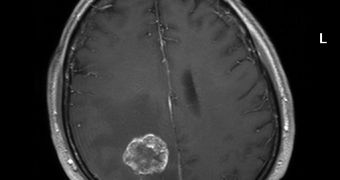Out of all types of brain tumors, glioblastoma is the most widespread and deadly one, affecting the vast majority of brain cancer patients. Within only a few months, the affected tissue spans the size of an apple, and death is the inevitable result. Despite decades of research, no viable cure for the condition has been devised to date, but that could soon change. A new study has revealed the 31 mutated gene-network that allows the tumor to adapt to drugs, as well as the gene that can fight it, but that is suppressed when the disease sets in.
One of the first things that glioblastomas do when they start developing in the brain is wipe out chromosome 10, which was just recently been found to be the source of the newly discovered Annexin A7 gene. The amounts of this gene in the tumors are used by doctors to determine exactly how long a patient has to live after the diagnostic is given. The recent paper, written by experts at the Northwestern University (NU) Feinberg School of Medicine (FSM), shows that A7 plays a vital role in stopping tumor growth, and that the tumors struggle to have it removed as early on as possible.
“These 31 genes are the kingpins in what you could call an organized crime network of genes that enable the tumor to grow with breathtaking speed. These 31 genes are highly connected to and affect hundreds of other genes involved in this process,” the Director of the Northwestern Brain Tumor Institute research program, Markus Bredel, M.D, explains. He is also an assistant professor of neurological surgery at the FSM, as well as the principal investigator of the two studies covering the finds, which appear in the July 15th issue of the Journal of the American Medical Association.
“We don't care about the gangster on the street. We wanted to find the big bosses. If you knock them out, then you have a big effect on all the other genes in the network,” he adds, quoted by ScienceDaily. In some 75 percent of the studied glioblastoma cases, the chromosome 10 has been entirely wiped out, and the A7 gene with it. This gene regulates the epidermal growth factor receptor (EGFR), which is a known oncogene. The latter gene was also observed to be expressed in abnormally high amounts in many types of cancers.
“Understanding the key role of Annexin A7 in malignant brain tumors offers the opportunity for a new therapeutic target. The challenge is now that we've established that this gene is important, how can we modulate it through molecular cancer therapy? We want to extend the survival of the patients, transform this hyper-acute disease into a more chronic tumor disease. Maybe someday, a glioblastoma patient will be able to live for 10 or 20 years after a diagnosis,” Bredel concludes.

 14 DAY TRIAL //
14 DAY TRIAL //